Bangladesh << `bahng` gluh DEHSH or `bang` gluh DEHSH >> is a densely populated nation in South Asia. Dhaka, formerly spelled Dacca, is Bangladesh’s capital and largest city. The region that is now Bangladesh once formed part of India, then part of Pakistan. Bangladesh gained independence in 1971.
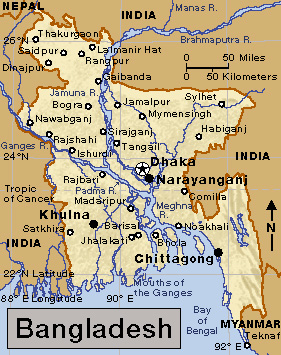
Much of Bangladesh sits on the great combined delta of the Padma (or Ganges), Jamuna (or Brahmaputra), and Meghna rivers, which meet in Bangladesh and flow south into the Bay of Bengal. India surrounds Bangladesh on the west, north, and east. The far southeast corner of Bangladesh borders Myanmar.
Bangladesh and the Indian state of West Bengal form a region known as Bengal. The name Bangladesh means Bengal nation. Almost 90 percent of the country’s people are Muslims. Most of the rest are Hindus, as are most of the people in West Bengal.
Bangladesh is one of the world’s poorest and most densely populated countries. Most Bangladeshis are poor farmers who struggle to feed themselves. Many laborers in the cities work for about a dollar a day.
Plant life thrives in the warm, humid climate of Bangladesh. Most of the country’s land consists of a flat, fertile flood plain. Countless rivers and frequent rain water the country’s crops. The rivers deposit fertile soil along their banks during periodic floods. However, many of the floods also cause widespread destruction in Bangladesh’s rural villages.
Bengal has been governed by Hindu, Muslim, and Buddhist rulers at various times in its history. An English trading company called the British East India Company helped the British to gain control of Bengal in the mid-1700’s. The United Kingdom ruled Bengal as one province, despite differences between the western part, which had more Hindus, and the eastern part, which had more Muslims.
Bloody conflicts between Hindus and Muslims throughout India led to the division of India into two nations in 1947, when India gained independence. Pakistan—consisting of East Pakistan and West Pakistan—was created out of the northeastern and northwestern parts of India. The majority of the people living in both areas were Muslims.
Numerous differences, both cultural and economic, divided the peoples of East Pakistan and West Pakistan. In 1971, civil war led to the establishment of East Pakistan as an independent country—Bangladesh. For more detailed information on the creation of Bangladesh, see the History section of this article.
Government
National government.
Bangladesh has a parliamentary system of government. The Parliament makes the country’s laws. It has 350 members who serve five-year terms. Three hundred members are elected directly by the people. The remaining seats are reserved for women elected by Parliament. A prime minister is the head of government and is chosen from the political party that wins the most seats in Parliament. The prime minister heads a cabinet, which helps carry out the functions of the government. Cabinet members are selected by the prime minister and appointed by the president.
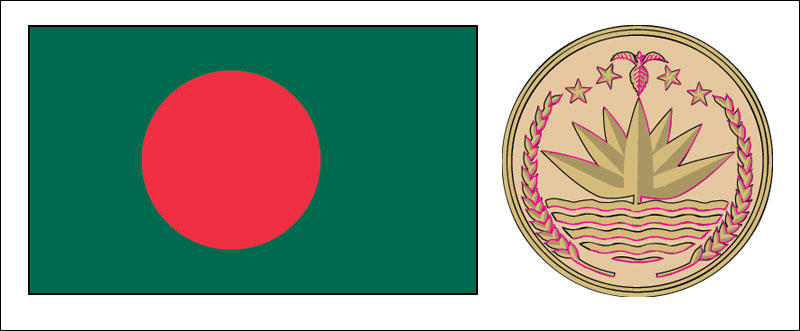
A president serves as head of state, but the position is mainly ceremonial. The president is elected by Parliament to a five-year term.
Loading the player...Bangladesh's national anthem
Local government.
Bangladesh is divided into eight administrative divisions—Barisal, Chittagong, Dhaka, Khulna, Mymensingh, Rajshahi, Rangpur, and Sylhet. Below these divisions are local government units called zilas (districts). The zilas are divided into units called thanas or upazilas, which are further divided into unions. Villages, the smallest units of government in Bangladesh, are grouped together to form the unions. The largest urban areas are designated city corporations and have elected mayors and councils.
Political parties.
Bangladesh has many political parties. The three most important parties are the Bangladesh Nationalist Party (BNP), the Jatiya Party, and the Awami League. The Awami League led the fight for independence in Bangladesh.
Armed forces.
Bangladesh has an army, an air force, and a navy. The country also has paramilitary forces.
People
Population and ancestry.
Bangladesh has one of the largest populations of any country. It is also one of the world’s most densely populated countries.
Most of the people of Bangladesh are probably descendants of peoples who migrated to the area thousands of years ago from the Indus Valley region in what are now Pakistan and northern India. The term Bangladeshis refers to all the people of Bangladesh. More than 95 percent of Bangladesh’s population belong to the Bengali ethnic group. They speak a language also called Bengali or Bangla.
Bangladesh has several minority groups. They include various ethnic groups that live mainly in the Chittagong Hills of southeastern Bangladesh. The largest groups include the Chakmas, the Marmas, the Mros, and the Tipperas. None of these groups practice Islam or speak Bengali as their native language. Some of their members have fought for greater self-rule.
Way of life.
Most Bangladeshis farm the land with simple tools, much as their ancestors had for hundreds of years. A few larger farms use modern agricultural machinery and techniques.
Clusters of thatch-roofed houses dot the countryside. Most rural villagers build homes made of bamboo. A typical home consists of only one or two rooms. Few homes in rural areas have electric power or plumbing.
Most families in cities and towns live crowded together in small houses. Some wealthy city families have large brick or concrete homes. In urban slums, the houses are built of cardboard, tin or plastic sheeting, scraps of wood, or sticks. Most Hindus and members of other minority groups live together in distinct neighborhoods.
Food production increased in the late 1900’s, and Bangladesh now raises enough to feed its large population. However, many poor Bangladeshis cannot afford an adequate supply of food.
Most people in Bangladesh have little variety in their meals. Rice, dal (lentils), and fish are the most important foods. They are usually served together in a spicy curry sauce. Tea flavored with milk and sugar is a popular beverage, but not everyone can afford it. Many Bangladeshis drink only water most of the time. 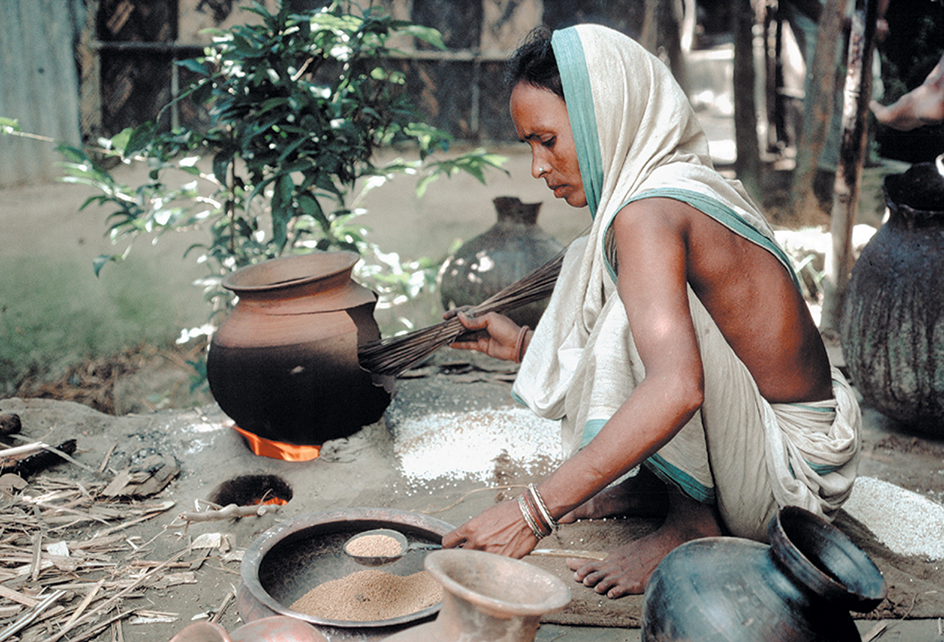
People throughout Bangladesh wear loose, lightweight clothing because of the warm, humid climate. Most of the women wear a sari, a long piece of plain or printed cloth wrapped around the waist and draped over one shoulder. They wear a short blouse under the sari. Many Muslim men wear a lungi, a tight skirtlike garment. The dhoti, worn by Hindu men, is a piece of cloth wrapped around the waist and between the legs. Men may also wear shirts. People in rural areas generally go barefoot. City dwellers may wear shoes or sandals.
Bangladeshis like to spend their leisure time chatting with friends and relatives. The men usually gather in cafes, and the women visit one another at home. The people enjoy the festivities held to observe religious holidays. Muslims celebrate a festival called `Īd al-Fitr, which marks the end of Ramadan, and other holidays. A favorite Hindu festival in Bangladesh is Durga Puja, which celebrates the goddess Durga. 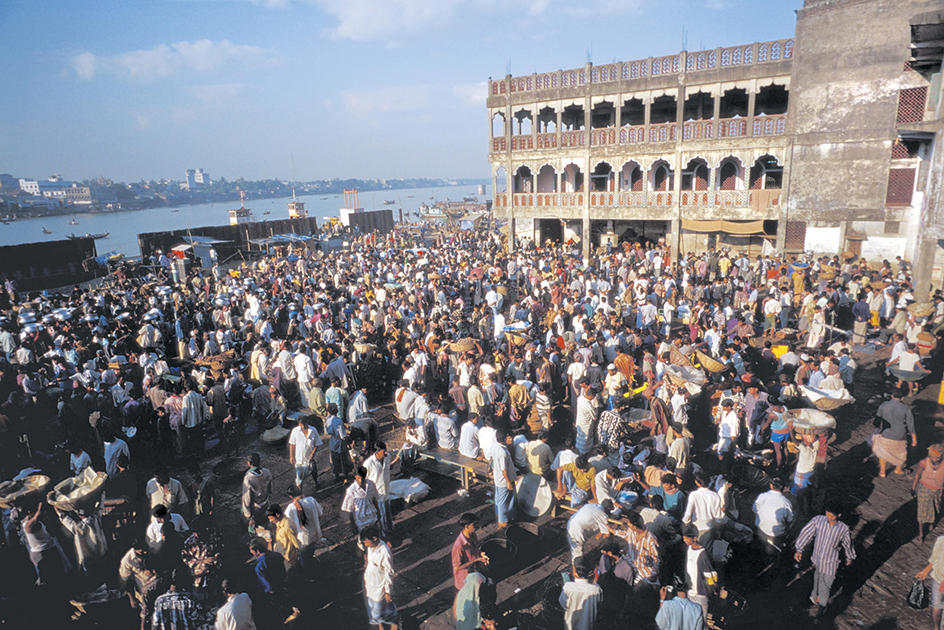
Religion.
Almost 90 percent of the people in Bangladesh are Muslims. In 1988, a constitutional amendment made Islam, the Muslim religion, the state religion of Bangladesh. Most Muslim parents arrange marriages for their children. A Muslim man may have up to four wives at a time. However, most Muslim men in Bangladesh are too poor to have more than one.
The men in a Muslim family have far more authority and freedom than the women have. Many Muslim women are forbidden social contact with men who do not belong to their family. They participate in few activities outside the home. Most Muslim women in Bangladesh cover their heads with veils in the presence of strangers.
About 10 percent of the people of Bangladesh are Hindus. Hindus are divided into various social classes called castes. Each caste observes its own customs and rules of behavior. But most Hindus in Bangladesh belong to castes of similar rank, so the caste system is less structured than in India. Hindu parents also arrange their children’s marriages, but Hindu women have more social freedom than Muslim women do.
Most of the ethnic groups of the Chittagong Hills area practice Buddhism. Some groups combine Buddhist principles with local religious beliefs.
Education.
About 75 percent of Bangladeshis 15 years of age or older can read and write. A law requires children to attend school for five years, beginning at age 6. But the law is not strictly enforced, and many youngsters do not attend school.
The University of Dhaka is the nation’s largest university. Dhaka is also the home of the Jahangirnagar Muslim University and the Bangladesh University of Engineering and Technology. Other universities are in Chittagong, Mymensingh, and Rajshahi.
Health.
Food shortages and unsanitary living conditions in Bangladesh contribute to outbreaks of cholera and other diseases of the digestive system, leprosy, tuberculosis, and other illnesses. Mosquitoes that spread malaria thrive in the nation’s swampy regions. Malaria kills thousands of Bangladeshis annually.
Millions of Bangladeshis have no source for healthy drinking water. For years, the people of the region obtained drinking water from shallow sources such as ponds and rivers. But this water was often contaminated with disease-causing bacteria. In the late 1900’s, international agencies helped install wells to avoid this problem. Unfortunately, water drawn from many of these wells is contaminated with naturally occurring arsenic, a poisonous chemical.
Bangladesh lacks enough hospitals and other health facilities for its large population. Because the country has more waterways than roads, speedboats serve as ambulances in some areas.
The arts.
Bengali literature has flourished for hundreds of years in the form of stories and folk ballads. These stories and ballads tell romantic legends and tales of everyday life. Dramas based on religious stories are popular forms of entertainment in Bangladesh. Rabindranath Tagore, a Bengali poet born in India, became prominent in Bengali literature during the late 1800’s. He won the Nobel Prize for literature in 1913 and remains a greatly respected literary figure.
Much of the traditional architecture of Bangladesh developed under Muslim rule during the 1500’s and 1600’s. This style features domes, towers, and pointed arches. Traditional painting uses the brilliant colors and elaborate decorations of Muslim religious art. Some contemporary artists of Bangladesh use techniques of modern Western art in painting everyday scenes and people, as well as in abstract designs.
The land
Almost all of Bangladesh consists of a flat, low-lying alluvial plain (land formed from soil deposited by rivers). Most of the country lies less than 50 feet (15 meters) above sea level. The far northeast and southeast corners of Bangladesh have many hills. Mount Keokradong, the country’s highest peak, rises 4,034 feet (1,230 meters) above sea level in the Chittagong Hills area in the southeast.
Rivers and streams.
Three major rivers—the Padma (or Ganges), the Jamuna (or Brahmaputra), and the Meghna—flow through the flat plains that cover most of Bangladesh. The names of these rivers change as they cross borders and join with one another. For example, the waterway known as the Brahmaputra becomes the Jamuna as it crosses from India into Bangladesh. Similarly, the river called the Ganges in India becomes the Padma in Bangladesh. When this river merges with the Jamuna, the joint river is called the Padma.
The country’s major rivers and their branches overflow during the rainy season and deposit fertile soil along their banks. The soil deposits that have built up at the mouths of the rivers form the broad Ganges Delta. Rice and jute, the most important crops of Bangladesh, thrive in the wet delta region.
Many small streams and canals also crisscross the country. Boats can reach almost every part of the Bangladesh interior. 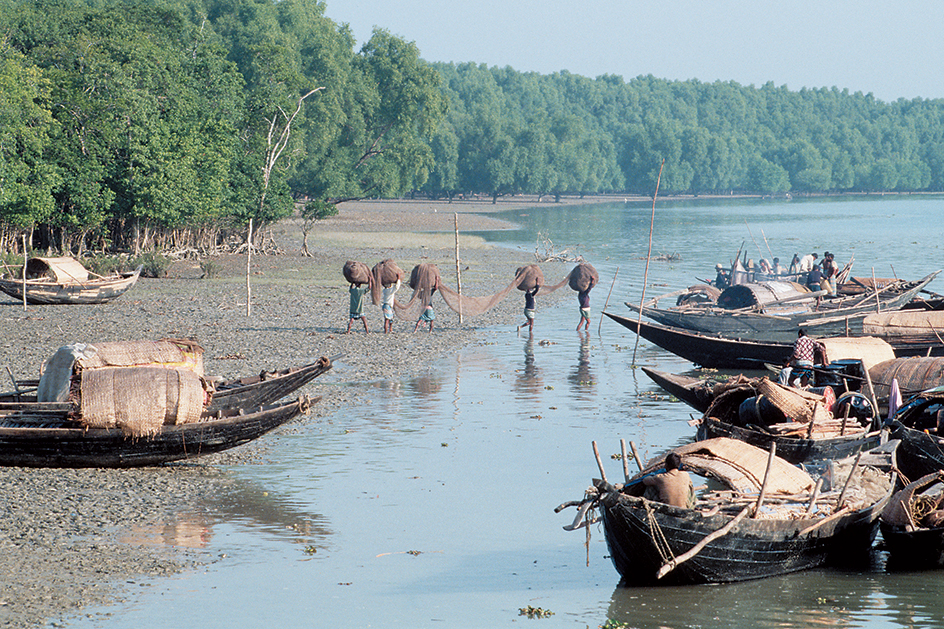
Coastline.
The coastline of Bangladesh extends 357 miles (575 kilometers) along the Bay of Bengal. Deep inlets mark the jagged coastline, and small islands dot the offshore delta area. Floods, tidal waves, and the flow of rivers, which deposit and remove soil particles called silt, change the features of the coastline frequently.
Forests.
Bamboo and such trees as mango, palm, and tamarind grow throughout most of Bangladesh. But the most valuable forest resources are in the Chittagong Hills in southeastern Bangladesh, and in the Sundarbans in the southwest. Teak is an important product of the Chittagong Hills forests. The Sundarbans are a swampy region covered by mangrove trees and other tropical plants. Bengal tigers live in this area.
Climate
Bangladesh is generally warm and humid throughout the year. The temperature varies little from one part of the country to another, though the north may be slightly cooler than the south in winter. Temperatures in Bangladesh average about 84 °F (29 °C) in April, one of the hottest months. January, the coldest month in Bangladesh, has an average temperature of 67 °F (19 °C).
Bangladesh receives ample rain. The eastern part of the country has an average annual rainfall of about 100 inches (250 centimeters), and the west has an average of about 65 inches (165 centimeters). The far northeastern region gets the most rain—as much as 250 inches (635 centimeters) a year.
In most years, the rainy season lasts from mid-March to the end of October. Afternoon thunderstorms occur frequently from mid-March to mid-May. The heaviest rain comes from mid-May to October, when seasonal winds called monsoons blow across the country. Many of the monsoon rains cause the rivers to overflow and flood the surrounding countryside.
Cyclones often strike Bangladesh at the end of the monsoon season. These violent storms may be accompanied by huge, destructive rushes of seawater called storm surges that rise from the Bay of Bengal and sweep across the low-lying countryside. Several cyclones and storm surges have destroyed towns and villages and killed thousands of people.
Economy
Bangladesh is one of the poorest nations of the world. It depends heavily on agriculture and has few natural resources. However, Bangladesh has a developing economy. Industry is growing rapidly, especially the manufacture of clothing and textiles.
Natural resources.
Fertile soil is probably the chief natural resource of Bangladesh. Forests once covered much of Bangladesh. In the 1900’s, most forestland was cleared for agriculture, and only a few wooded areas remain. Natural gas and petroleum have been discovered in the northeast and in the coastal waters.
Agriculture
is an important economic activity in Bangladesh. About half of the people farm the land. Many farmers have little or no land of their own. They engage in sharecropping—raising crops on someone else’s land and paying the owner with a share of the harvest. 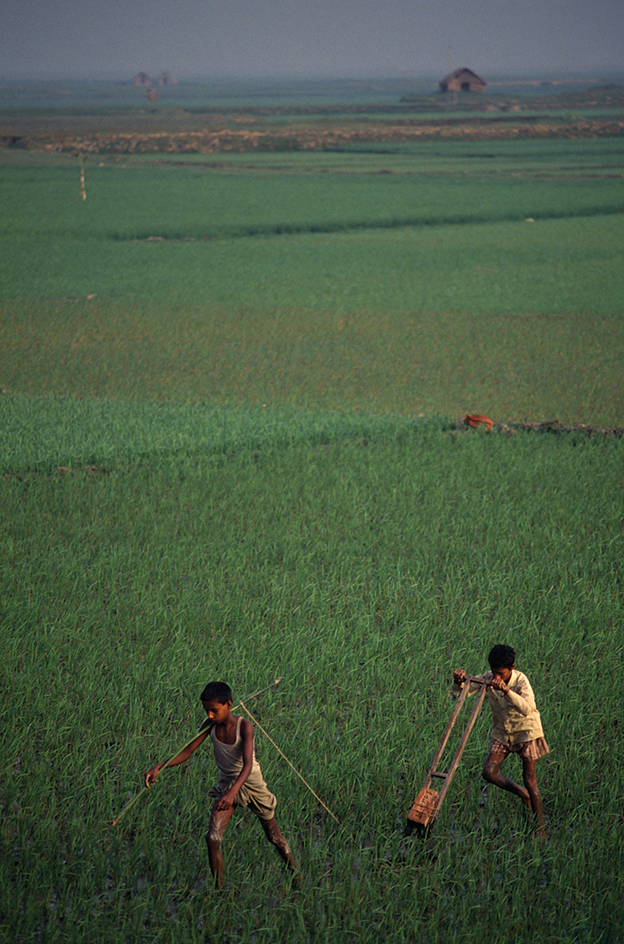
Because the temperature stays warm, farmers can grow crops all year long, provided there is enough water. During wet months, farmers grow rice and other crops that need much water. In dry months, they plant wheat and other crops that grow in drier ground, or they use irrigation to continue growing the wet crops. With the right conditions, farmers can produce three crops in a year.
Bangladesh ranks among the world’s leading rice-growing countries. Jute, a plant whose fibers are made into string or woven into sacking or carpet backing, is Bangladesh’s chief export crop. Bangladesh is one of the world’s leading producers of jute. Farmers also grow corn, potatoes, sugar cane, tea, and tobacco.
Many farmers in Bangladesh raise livestock. Farmers use cattle or buffaloes to pull their plows, and they sell the hides to the country’s leather industry. Many farm families also raise chicken or goats.
Manufacturing.
Bangladesh has a long history of making handcrafted goods. Muslin cloth, a fine cotton cloth, has been made in Bangladesh for hundreds of years. Many Bangladeshis still work in their homes making craft items. Some craftworkers weave cotton, jute, or silk into cloth. Others make embroidered items, leather goods, pottery, or bowls and other items carved from wood. Still others make articles of brass, copper, gold, or silver. 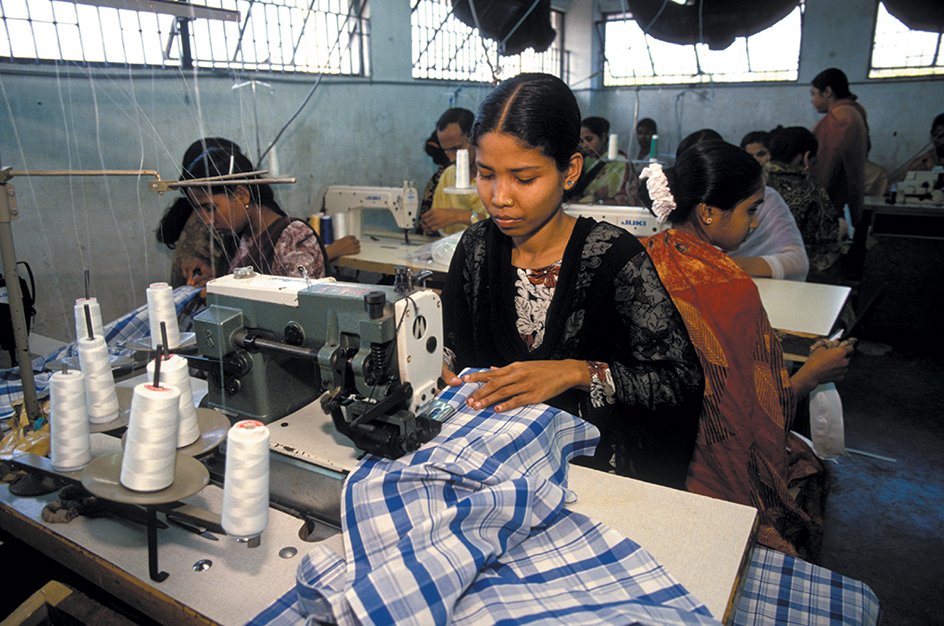
Many modern factories in Bangladesh make clothing, the country’s leading manufactured product. Other factories produce electronics, fertilizers, food products, leather goods, paper and paper products, pharmaceuticals, and textiles. Many factories process jute by spinning the raw fibers into string and rope, which may then be woven into burlap or other materials.
Fishing industry.
Fish thrive in the many inland waterways of Bangladesh and in the coastal waters of the Bay of Bengal. The people catch large quantities of fish for their own use and for export. Aquaculture, the commercial raising of animals and plants that live in water, is important to Bangladesh. Carp, catfish, and shrimp are valuable products. 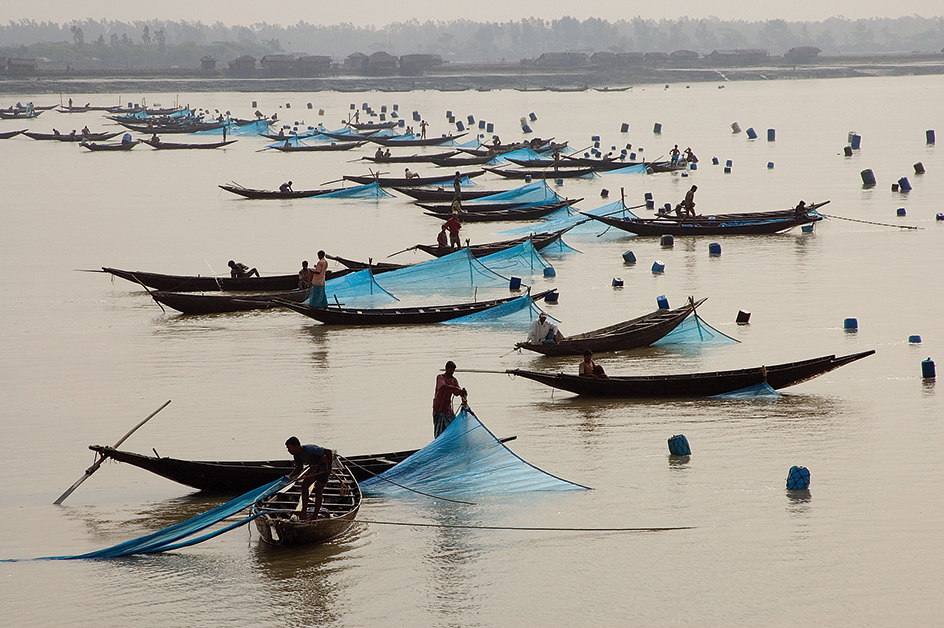
International trade.
Bangladesh imports more than it exports. The country’s leading imports include building materials, chemicals, cotton, food and food products, machinery, petroleum, textiles, and transportation equipment. Clothing is the main export of Bangladesh, accounting for more than three-fourths of the country’s export income. Bangladesh also exports fish, jute, and leather. The country’s main trading partners include China, Germany, India, Singapore, and the United States.
Transportation.
Waterways serve as important transportation routes in much of Bangladesh. Passenger and cargo ships make regular trips on the major rivers between the largest cities and towns. Chittagong is the nation’s chief seaport. State-owned Bangladesh Railway provides railroad service throughout the country. Bangladesh has international airports at Dhaka, Chittagong, and Sylhet. 
Building roads is difficult and expensive in Bangladesh because of the need to construct bridges across the country’s numerous rivers and streams. Many of the country’s roads and railroads become unusable during the monsoon season, when heavy flooding occurs.
Communication.
Bangladesh has both Bengali and English-language newspapers. The government runs several radio stations and television stations. The country also has several private radio and television stations. Few homes in rural Bangladesh have radios or televisions, so people gather in public places for broadcasts. Wireless telephones have become increasingly popular in Bangladesh.
History
Early history.
Historians believe that a tribal people called the Bang inhabited the area that is now Bangladesh and West Bengal around 1000 B.C. The region probably took its name from the Bang, becoming known as Bengal. In the 200’s B.C., Bengal became part of the Mauryan Empire, which ruled much of south Asia. The Mauryan Empire broke up about 185 B.C., and local kings then ruled Bengal. From about A.D. 320 to 500, much of the region was part of the Gupta Empire.
Buddhist rulers gained control of Bengal in the mid-700’s, and Buddhist culture took hold throughout the region. After about 300 years of Buddhist rule, Hindu kings came to power. During the late 1100’s, invading Muslims from central Asia established a sultanate (government by a sultan) in Delhi, in northern India. The Delhi Sultanate soon extended its control over Bengal. Independent Muslim rulers governed parts of Bengal until 1576, when the Mughal emperor Akbar, also a Muslim, conquered the region.
Mughal rule.
The Mughal Empire spread across most of what are now Afghanistan, Bangladesh, India, and Pakistan. Muslim art and architecture flourished under Mughal rule. Gradually, the Buddhist and Hindu people of Bengal converted to Islam.
The Mughal emperors appointed governors called nawabs to rule the provinces of the empire. In the early 1700’s, the empire began to break up, partly because powerful Hindu groups in central and western India rebelled against Muslim rule. At the same time, Bengal and other provinces became increasingly independent as the nawabs took more power for themselves.
The growth of European influence.
During the 1500’s, British, Dutch, French, and Portuguese traders competed for control of the profitable trade between the East Indies and Europe. By the 1600’s, European trade settlements had been established in Bengal. At first, the Europeans met strong resistance from the provincial nawabs, who demanded taxes in return for trade privileges. But after the Mughal Empire began to weaken in the 1700’s, European influence increased. Ambitious Mughal nawabs, nobles, and generals competed for power. The Europeans took sides in many of these conflicts, offering their support in return for exclusive trading privileges and other rewards.
The East India Company
was chartered by the English government in 1600 to develop trade with India and the Far East. In the mid-1700’s, the company gained control of Bengal. In 1757, forces led by Robert Clive, an agent of the East India Company, defeated the nawab of Bengal in the Battle of Plassey. Clive put a puppet nawab in office, but the East India Company actually ruled Bengal. In 1773, Calcutta (now Kolkata) in western Bengal became the capital of all of India.
Company officials made huge profits in Bengal, but they did little to improve the welfare of its people. Opposition to the company spread, both in Bengal and in other areas of India controlled by the firm. The discontent led to the Indian Rebellion in 1857. The revolt failed, but it caused the British government to take over the company in 1858. All the Indian territory that the firm had governed became known as British India.
British India.
Bengal became a province of British India. Under British rule, industrial development and educational reforms advanced rapidly in western Bengal, where most of the people were Hindus. Many Hindus gained economic and political power. But eastern Bengal, where most people were Muslims, remained undeveloped and agricultural. In 1905, the viceroy (governor) of British India divided Bengal into two sections—West Bengal and East Bengal. East Bengal became part of a new province.
Many nationalist Bengalis, especially Hindus, opposed the division. It created a Muslim majority in East Bengal, while non-Bengali ethnic groups outnumbered Bengalis in the West. Bengali Muslims initially opposed the division, but they came to favor it for the new opportunities it offered. The conflict led to bloody rioting between Hindus and Muslims in Bengal. The British reversed the division in 1911, and Bengal again became a single province. But the bitterness between Hindus and Muslims remained.
Throughout British India, nationalism took root in the late 1800’s and early 1900’s. The Muslim League, a political organization formed in 1906, became the voice of India’s Muslim minority. In 1940, league leaders demanded independent Muslim lands in northwestern and northeastern India. The name Pakistan came to be used for the proposed Muslim homelands. Riots between Hindus and Muslims in the 1940’s convinced government leaders that India would have to be divided. In 1947, the United Kingdom granted independence to India and established Pakistan as an independent nation. The British divided Bengal between the two countries. Western Bengal became a state of India. Eastern Bengal became East Pakistan.
East Pakistan
was separated from West Pakistan by about 1,000 miles (1,600 kilometers) of Indian territory. The people of the two parts of Pakistan shared a common religion, but they had little else in common. They spoke different languages and had different cultures, traditions, and ethnic backgrounds. East Pakistanis made up more than half the population of Pakistan, but West Pakistanis controlled the nation’s government, economy, and armed forces. East Pakistanis resented the economic inequalities between the two regions. Also, the government’s decision to make Urdu the national language angered Bengali speakers in East Pakistan.
East Pakistanis grew dissatisfied with the government of Pakistan. In November 1970, a cyclone and storm surge struck East Pakistan and killed from 300,000 to 500,000 people. Many East Pakistanis accused the government of delaying shipments of relief supplies to the devastated areas.
In December 1970, elections were held throughout Pakistan to choose an assembly that would serve as a legislature and write a new constitution. The Awami League, a party led by East Pakistan’s Sheikh Mujibur Rahman (known as Sheikh Mujib), won a majority of the seats. The party strongly supported increased self-government for East Pakistan. 
On March 1, 1971, President Yahya Khan of Pakistan postponed the first meeting of the assembly. East Pakistanis protested, and Yahya Khan sent army troops to East Pakistan to put down the protests. Sheikh Mujib was imprisoned in West Pakistan.
Civil war
soon broke out. The fighting began in East Pakistan. Then, on March 26, 1971, the East Pakistanis declared East Pakistan an independent nation called Bangladesh. They formed a guerrilla army to fight the government troops. Thousands of civilians died in the bloody fighting that followed, and millions of refugees poured into India.
During the early months of the civil war, East Pakistani guerrillas also crossed into India. The Pakistani government forces shelled Indian territory and followed the guerrillas across the border. Indian troops fought border clashes with the Pakistani government soldiers. In December 1971, the Indian Army advanced into East Pakistan and joined the guerrillas. The combined forces of the Indians and guerrillas overpowered West Pakistan, which surrendered on Dec. 16, 1971.
The new nation.
Sheikh Mujib was released from prison in January 1972. He returned to Bangladesh in triumph and became the nation’s first prime minister.
Bangladesh faced staggering problems as an independent country. Millions of its people were homeless. Trade, transportation routes, and communication lines had to be restored. Hospitals, factories, and schools lay in ruins. Reconstruction began quickly. But floods and food shortages caused much suffering, and charges of corruption weakened the government.
In January 1975, Bangladesh amended its Constitution to give the president all executive power. Mujib resigned as prime minister and took office as president. He soon suspended all opposition political parties and declared Bangladesh a one-party state. In August 1975, military leaders killed Mujib. They dissolved the Parliament, took control of the government, and began to rule under martial law. Ziaur Rahman (known as Zia), an army officer, became head of the martial law government in November. He took the title of president in 1977. In 1978, the people elected Zia president. In 1979, Zia became head of the Bangladesh Nationalist Party (BNP), which had formed after the 1978 elections.
In 1979, the military leaders ended martial law, and the people elected a new Parliament. Zia remained president. In 1981, rebels led by a military officer killed Zia. Vice President Abdus Sattar was elected president later that year. In 1982, military leaders again took control of the government. Lieutenant General H. M. Ershad suspended the Constitution and established martial law. From 1982 to 1984, Ershad banned the activity of political parties. He took the title of president in 1983.
In May 1986, Ershad allowed the first parliamentary elections in Bangladesh since 1979. In August, Ershad resigned from the army to run as a civilian candidate for president. He became head of the Jatiya Dal, a party formed by his supporters. In October 1986, the people elected him president. That November, the Parliament passed a law protecting Ershad from prosecution for actions taken during the period of martial law. He then ended martial law and restored the Constitution. In late 1990, thousands of people held violent protests against Ershad’s government. Ershad resigned as president in December.
Elections were held in February 1991. The BNP gained control of Parliament, and its leader, Khaleda Zia, became prime minister. Khaleda Zia, the widow of President Zia, was the first woman to serve as prime minister of Bangladesh. In September 1991, Bangladesh amended its Constitution and returned executive power to the prime minister. The position of president became mainly ceremonial.
Recent developments.
The BNP won parliamentary elections in February 1996. But the elections were marred by charges of election fraud, violence at the polls, and low voter turnout. The country held elections again in June 1996. In that vote, the Awami League won the most seats in Parliament, and its leader, Sheikh Hasina Wajed, became prime minister. Sheikh Hasina is the daughter of the country’s first prime minister, Sheikh Mujib.
Parliamentary elections in 2001 returned the BNP to power. Khaleda Zia again became prime minister. After Zia’s term ended in October 2006, President Iajuddin Ahmed became the temporary head of government to supervise elections. However, after weeks of demonstrations and charges of election rigging, Ahmed declared a state of emergency in January 2007 and stepped down from the temporary post. A military-backed caretaker government took control of the country. Ahmed remained in the mainly ceremonial job of president until early 2009.
On Dec. 29, 2008, parliamentary elections were held. The Awami League won 230 out of 300 parliamentary seats. Sheikh Hasina was sworn in as prime minister on Jan. 6, 2009, restoring democratic rule to the country.
Bangladesh suffered its worst ever industrial accident in 2013. On April 24, a building housing several textile factories collapsed in a suburb of Dhaka, killing about 1,130 people. Investigators determined that the building owner had illegally added floors to the building and had installed heavy machinery that the building could not support. The disaster drew international attention to the dangerous working conditions in many of Bangladesh’s garment factories. In May, Bangladesh’s government announced plans to increase pay for garment workers and to make it easier for them to form labor unions. See Rana Plaza disaster. 
The Awami League won a majority of seats in parliamentary elections held in 2014, 2018, and 2024. Sheikh Hasina remained prime minister following each of these elections. The BNP boycotted (did not participate in) the elections held in 2014 and 2024.
In July and August 2024, violent protests against Sheikh Hasina’s government broke out across Bangladesh. Hundreds of people were killed in the protests. In early August, Sheikh Hasina resigned as prime minister and fled to India. President Mohammad Shahabuddin Chuppu then dissolved the national Parliament. He named the Bangladeshi banker Muhammad Yunus to lead an interim (temporary) government as its chief adviser.
